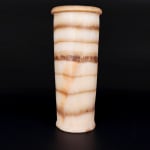Predynastic Cylinder Beaker, 4000 BCE - 3000 BCE
Alabaster
30.5 x 13 cm
12 x 5 1/8 in
12 x 5 1/8 in
CC.58
Further images
-
(View a larger image of thumbnail 1
)

-
(View a larger image of thumbnail 2
)

-
(View a larger image of thumbnail 3
)

-
(View a larger image of thumbnail 4
)

-
(View a larger image of thumbnail 5
)

-
(View a larger image of thumbnail 6
)

-
(View a larger image of thumbnail 7
)

-
(View a larger image of thumbnail 8
)

-
(View a larger image of thumbnail 9
)

Stone vessels are the characteristic finds in Predynastic Egyptian tomb sites. Whereas pottery vessels were more practical for everyday use, since they were cheap and disposable, stone vessels are specifically...
Stone vessels are the characteristic finds in Predynastic Egyptian tomb sites. Whereas pottery vessels were more practical for everyday use, since they were cheap and disposable, stone vessels are specifically associated with the afterlife. Some may have contained foodstuffs for the nourishment of the ka (spirit) of the deceased, but the vessels themselves also seem to have been ritually significant in their own right. In the afterlife, the deceased needed analogues of the possessions they used in daily life if they were to enjoy the same benefits after death. Even empty, these vessels served their ritual function. The craftsmanship required to produce such stone vases was significant. The outside of the vessel would be roughly carved, before the artisan bored out the middle of the vessel with a bow-drill. Once this laborious task was complete, the vessel was smoothed with different grades of stone.
This sizeable cylinder beaker rises from an everted foot through a slender, slightly tapering, shape, to an overturned round rim. This form was borrowed directly from pottery, and later evolved into one of the classic shapes of Egyptian ceramic and stone vase-making. The vase is of considerable size, too large for most daily functions. It is probable, then, that rather than containing an actual foodstuff or other good, the vase was instead a statement of the aspirations of the deceased to be well-provided-for in the afterlife. The artist has made a particular effort to make the most of the banding of the alabaster, which runs horizontally across the vase in a highly decorative manner.
The durability of stone vessels shows the concern of the earliest Egyptians for the long-term provision of their souls in the afterlife. It therefore reflects the nascent beliefs which would grow into the rich and developed funerary customs for which the Egyptians were to later become famous. This vase shows the quality of workmanship that went into the funerary goods of the Predynastic Period, and the ability of the artist to translate forms from one medium to another.
References: a vase of similar design and size can be found in Madrid (Museo Arqueológico Nacional 16051).
This sizeable cylinder beaker rises from an everted foot through a slender, slightly tapering, shape, to an overturned round rim. This form was borrowed directly from pottery, and later evolved into one of the classic shapes of Egyptian ceramic and stone vase-making. The vase is of considerable size, too large for most daily functions. It is probable, then, that rather than containing an actual foodstuff or other good, the vase was instead a statement of the aspirations of the deceased to be well-provided-for in the afterlife. The artist has made a particular effort to make the most of the banding of the alabaster, which runs horizontally across the vase in a highly decorative manner.
The durability of stone vessels shows the concern of the earliest Egyptians for the long-term provision of their souls in the afterlife. It therefore reflects the nascent beliefs which would grow into the rich and developed funerary customs for which the Egyptians were to later become famous. This vase shows the quality of workmanship that went into the funerary goods of the Predynastic Period, and the ability of the artist to translate forms from one medium to another.
References: a vase of similar design and size can be found in Madrid (Museo Arqueológico Nacional 16051).








